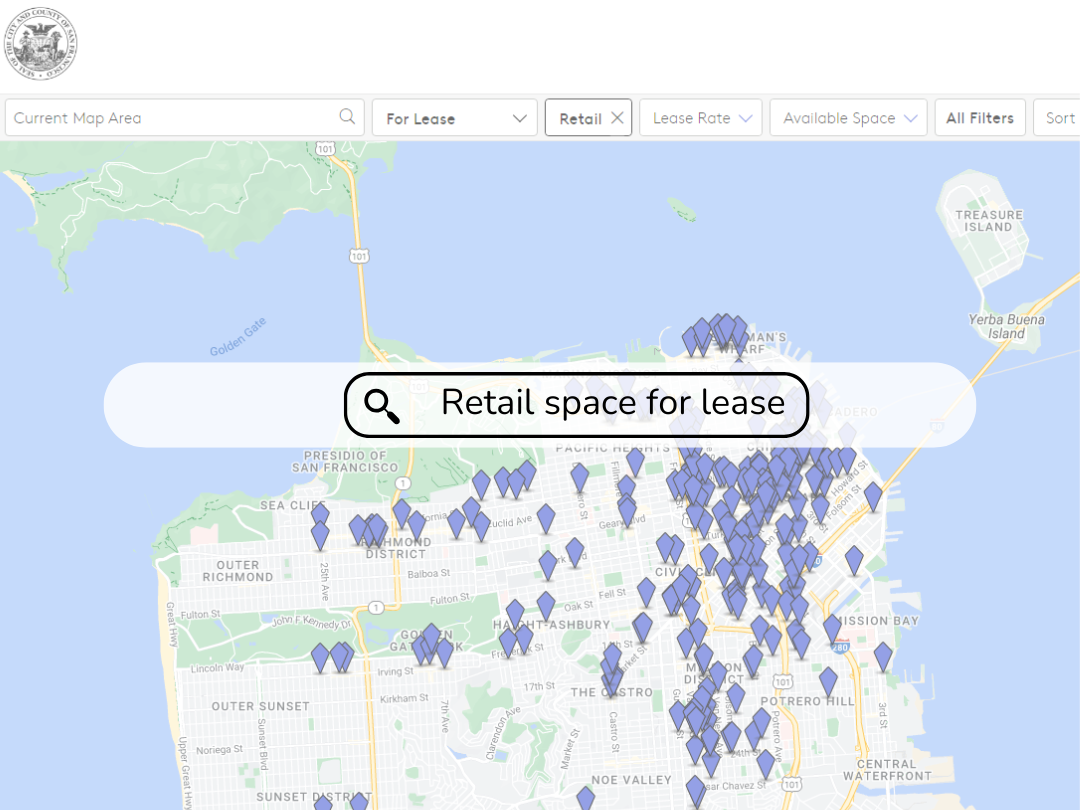CAMPAIGN
Find a commercial location for your business
CAMPAIGN
Find a commercial location for your business

Search available spaces
Filter for commercial spaces by type, size, location, rate, and more. Connect with a Commercial Leasing Specialist for one-on-one help by emailing sfosb@sfgov.org or calling 415-554-6134.SearchDecide on your preferred neighborhood
Assess factors like demographics, safety, traffic, zoning and building requirements, and accessibility.
Demographics
Neighborhood demographics tell you who your customers and neighbors are – their age, gender, income, education, family size, even what kind of food they like to eat. Knowing these demographics can help you understand your market and target certain types of customers.
Safety
Your building and the area around it should feel safe to your customers and employees. Consider whether the location is well lit, what the crime rate is in the area, and whether or not you need a security system or security guard.
Traffic
Traffic refers to both where people are driving and where they are walking: car traffic and pedestrian traffic. Restaurants and retailers must consider traffic information including how many people pass by your location, at what times of day and in what direction.
Get leasing tips
Find out if you are allowed to operate your business in the building or location you are considering. If you tie yourself to an area or space you cannot use because of conflict with zoning regulations, you could lose your rent deposit or be stuck paying for a place you cannot use.
Research zoning
Find out if you are allowed to operate your business in the building or location you are considering. If you tie yourself to an area or space you cannot use because of conflict with zoning regulations, you could lose your rent deposit or be stuck paying for a place you cannot use.
Ask a Small Business Permit Specialist to confirm that you’ll be allowed to conduct your business from your chosen location.
Email: sfosb@sfgov.org
Call: 628-652-4949
Schedule an appointment in person at the San Francisco Permit Center
Read the fine print
Find out about hidden costs
Very few spaces are turnkey ready. Be sure to consider costs like renovation, decorating, IT system upgrades, and so on.
Ask about ADA Compliance
Landlords are required to make public restrooms and ground-floor entrances/exits accessible, or give you notice if the space may not be ADA compliant. Other aspects of ADA compliance will be your responsibility, and you should consult with a CASp (Certified Access Specialist) to help determine the cost of any required improvements.
Learn more about accessibility for business.
Negotiate the lease
Research similar sites in the neighborhood so you can show your landlord the market costs of nearby sites. Review multiple sites to know more about the market. This will help you negotiate the lease in your favor.
If you'd like help reviewing your lease, contact the Office of Small Business by emailing sfosb@sfgov.org
Include contingencies
When negotiating a lease, make sure it is flexible enough, or specifically allows for delays in case it takes longer than expected to obtain your permits.
Understand the lease clauses
Read through all the important clauses in your lease, including how rent is calculated and quoted, the term of the lease, the start date of the lease, and what happens if the landlord decides to sell the property. Understand how communication with the landlord will work, like how you'll contact them when a repair is needed or when it's time to renew your option.
Plan an exit strategy
If you can, negotiate a lease that allows you to transfer your business to a new owner, just in case something happens to cause your business to fail. The clause that allows you to sell your business is called an assignment clause.
Contact a Commercial Leasing Specialist
The Office of Small Business provides one-on-one leasing help for small businesses looking for a location, at the LOI or lease stage, or needing help with an existing lease.
Email: sfosb@sfgov.org
Call: 628-652-4949